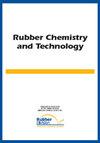METHOD TO GENERATE ACCURATE ELASTIC AND HYPERELASTIC UNIAXIAL TENSION STRESS–STRAIN DATA WITHOUT AN EXTENSOMETER
IF 1.5
4区 工程技术
Q4 POLYMER SCIENCE
引用次数: 0
Abstract
Uniaxial tension tests on dumbbells are routinely used to determine the stress–strain response of engineering materials. The simplest way to calculate strain is from grip displacement during extension, but this introduces significant error when dumbbells are gripped at the wider end sections to avoid the sample breaking prematurely in the grips. Mechanical and optical extensometers alleviate this problem by directly measuring strain in the gauge section. However, the equipment introduces significant additional hardware and software costs, and some experimental setups obstruct or prevent direct measurement of strain. The strain following systems also struggle both with the loss in mark intensity and changes of the shape of the marked point as the strain level is increased. To address these shortcomings, a novel analytical model to correct stress–strain data based on grip displacement is proposed. The model is implemented in Fortran and applied to hyperelastic materials which are assumed isotropic, but in principle the method is not restricted to elastomers. The model is validated with three studies on dumbbells: (i) a finite-element analysis for strains up to 660%; (ii) an experimental test with unfilled natural rubber up to 300% strain using a video extensometer; and (iii) a high temperature experimental test to fracture where the strain is corrected for a filled rubber. The model errors range from 2.2% to 3.1%, which is well within material and experimental uncertainties; hence, the model provides an accurate, inexpensive means of determining stress–strain behavior from grip displacement.无需伸长计生成精确弹性和超弹性单轴拉伸应力-应变数据的方法
哑铃的单轴拉伸试验通常用于确定工程材料的应力-应变响应。计算应变的最简单方法是根据拉伸过程中的夹具位移,但当哑铃在较宽的端部被夹住时,这会引入显著的误差,以避免样品在夹具中过早断裂。机械和光学伸长计通过直接测量应变计截面中的应变来缓解这个问题。然而,该设备引入了显著的额外硬件和软件成本,并且一些实验设置阻碍或阻止了应变的直接测量。随着应变水平的增加,应变跟随系统还与标记强度的损失和标记点的形状的变化作斗争。为了解决这些缺点,提出了一种新的基于握把位移的应力-应变数据校正分析模型。该模型在Fortran中实现,并应用于假设各向同性的超弹性材料,但原则上该方法不限于弹性体。通过对哑铃的三项研究验证了该模型:(i)高达660%的应变的有限元分析;(ii)使用视频伸长计对未填充的天然橡胶进行高达300%应变的实验测试;和(iii)断裂的高温实验测试,其中对填充橡胶的应变进行校正。模型误差在2.2%到3.1%之间,完全在材料和实验的不确定性范围内;因此,该模型提供了一种准确、廉价的方法来确定握把位移的应力-应变行为。
本文章由计算机程序翻译,如有差异,请以英文原文为准。
求助全文
约1分钟内获得全文
求助全文
来源期刊

Rubber Chemistry and Technology
工程技术-高分子科学
CiteScore
3.50
自引率
20.00%
发文量
21
审稿时长
3.6 months
期刊介绍:
The scope of RC&T covers:
-Chemistry and Properties-
Mechanics-
Materials Science-
Nanocomposites-
Biotechnology-
Rubber Recycling-
Green Technology-
Characterization and Simulation.
Published continuously since 1928, the journal provides the deepest archive of published research in the field. Rubber Chemistry & Technology is read by scientists and engineers in academia, industry and government.
 求助内容:
求助内容: 应助结果提醒方式:
应助结果提醒方式:


